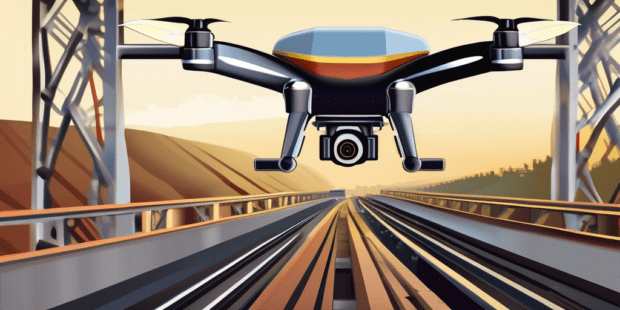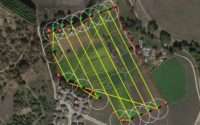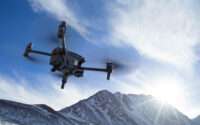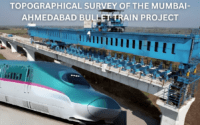Railway Projects with UAV Technology
Overview
Introduction to UAV technology
Unmanned Aerial Vehicles (UAVs), also known as drones, have emerged as a game-changing technology in various industries, including railway projects. These remotely controlled aircraft have the ability to capture high-resolution images, collect data, and perform tasks that were once time-consuming and costly. With their versatility and maneuverability, UAVs have revolutionized the way railway projects are executed. They offer a range of benefits, including improved efficiency, cost-effectiveness, and safety. However, the integration of UAV technology in railway planning is not without its challenges. It requires careful consideration of regulatory and privacy issues, as well as the need for skilled operators and data analysis expertise.
Benefits of using UAVs in railway projects
Using UAVs in railway projects offers numerous benefits. Firstly, it allows for efficient surveying and mapping of railway tracks and surrounding areas, providing accurate data for project planning. Secondly, UAVs enable the inspection and maintenance of railway infrastructure, allowing for the timely identification and repair of any issues. Lastly, UAVs facilitate construction monitoring, providing real-time data on the progress of railway projects. Overall, the use of UAV technology in railway projects improves efficiency, reduces costs, and enhances safety measures.
Current challenges in railway projects
Railway projects face several challenges that can impact their efficiency and effectiveness. Limited accessibility to remote and difficult-to-reach areas makes it challenging to gather accurate data for planning and construction. Manual surveying methods are time-consuming and can lead to errors. Additionally, safety concerns during inspection and maintenance activities pose risks to workers. These challenges highlight the need for innovative solutions, such as UAV technology, to overcome these limitations and revolutionize railway projects.
UAV Applications in Railway Projects
Surveying and mapping
UAV technology has revolutionized the way surveying and mapping are conducted in railway projects. Drones equipped with high-resolution cameras and LiDAR sensors can quickly and accurately capture aerial imagery and topographic data of the railway corridor. This data can then be processed and analyzed to create detailed maps and 3D models of the project area. The use of UAVs in surveying and mapping not only reduces the time and cost involved in traditional ground-based methods but also improves the accuracy and efficiency of data collection. Furthermore, the ability of UAVs to access hard-to-reach areas and capture data from different angles provides a comprehensive view of the railway infrastructure. This enables engineers and planners to make informed decisions and identify potential issues before they escalate. Overall, the integration of UAV technology in surveying and mapping has significantly enhanced the planning and design phase of railway projects.
Inspection and maintenance
UAV technology has revolutionized the inspection and maintenance processes in railway projects. Drones equipped with high-resolution cameras and sensors can quickly and accurately assess the condition of railway infrastructure, such as tracks, bridges, and tunnels. This enables efficient and cost-effective monitoring of potential issues, such as cracks, corrosion, or structural damage. Additionally, UAVs can provide real-time data on maintenance needs, allowing for timely repairs and reducing the risk of accidents or service disruptions. The use of UAVs in inspection and maintenance not only improves the overall safety of railway operations but also helps to extend the lifespan of infrastructure assets, resulting in long-term savings for railway companies.
Construction monitoring
Construction monitoring is another key application of UAV technology in railway projects. Drones equipped with high-resolution cameras and sensors can provide real-time monitoring of construction activities, allowing project managers to track progress, identify potential issues, and make informed decisions. The construction team carries out the construction according to the specified plans and timelines, minimizing delays and cost overruns. Additionally, UAVs can capture detailed images and videos of the construction site, enabling better documentation and analysis of the project. Overall, the use of UAVs in construction monitoring enhances efficiency, accuracy, and safety in railway projects.
Integration of UAV Technology in Railway Planning
Data collection and analysis
Data collection and analysis play a crucial role in the integration of UAV technology in railway planning. UAVs equipped with advanced sensors and cameras can collect high-resolution images and LiDAR data, allowing for detailed topographic mapping and terrain analysis. Machine learning algorithms and geospatial software can process and analyze the collected data, providing valuable insights for efficient project planning and decision-making. Furthermore, the use of drones for data collection significantly reduces the time and cost involved in traditional surveying methods. By leveraging UAV technology, railway projects can benefit from accurate and up-to-date data, leading to improved project efficiency and better resource allocation.
Improved project efficiency
One of the key advantages of integrating UAV technology in railway planning is the significant improvement in project efficiency. By using UAVs for data collection and analysis, railway projects can gather accurate and up-to-date information in a fraction of the time compared to traditional methods. This enables project managers to make informed decisions quickly and efficiently, leading to streamlined project timelines and cost savings. Additionally, using UAVs in construction monitoring enables real-time progress monitoring, ensuring that projects stay on track and promptly identify and address any issues. Overall, the integration of UAV technology in railway planning greatly enhances project efficiency and contributes to the successful completion of railway projects.
Enhanced safety measures
Incorporating UAV technology in railway projects not only improves efficiency but also enhances safety measures. Real-time monitoring of construction sites and inspection of infrastructure can identify potential hazards and address them promptly. UAVs can also be used for surveillance and security purposes, ensuring the safety of railway personnel and passengers. Additionally, the collection and analysis of data obtained from UAVs can help identify safety risks and implement preventive measures. By integrating UAV technology, railway projects can prioritize safety and minimize accidents and incidents.
Conclusion
Potential for future advancements
The potential for future advancements in UAV technology for railway projects is immense. As the technology continues to evolve, new and innovative applications are being explored. One area of focus is the development of autonomous UAVs that can perform tasks such as inspection and maintenance without human intervention. Another area of potential advancement is the use of artificial intelligence and machine learning algorithms to analyze the vast amount of data collected by UAVs, enabling more accurate and efficient decision-making. Additionally, advancements in sensor technology are expected to improve the quality and accuracy of data collected by UAVs. Future advancements can potentially revolutionize the way we plan and execute railway projects, leading to significant improvements in project efficiency, safety measures, and cost savings.
Impact on the Railway Industry
The integration of UAV technology in railway projects has the potential to revolutionize the industry. By leveraging the capabilities of UAVs for surveying, mapping, inspection, and construction monitoring, railway projects can benefit from improved data collection and analysis, leading to enhanced project efficiency. Moreover, the use of UAVs can also contribute to enhanced safety measures by reducing the need for manual inspections and providing real-time monitoring of critical infrastructure. Overall, the adoption of UAV technology in railway planning has the power to transform the way projects are executed, resulting in cost savings, time efficiency, and better project outcomes.
Summary of benefits and challenges
In summary, the integration of UAV technology in railway projects brings numerous benefits, including improved project efficiency, enhanced safety measures, and the potential for future advancements. However, we need to address challenges such as data collection and analysis, as well as the impact on the railway industry. Despite these challenges, the use of UAVs in railway projects is revolutionizing the industry and paving the way for more efficient and effective project planning and execution.




